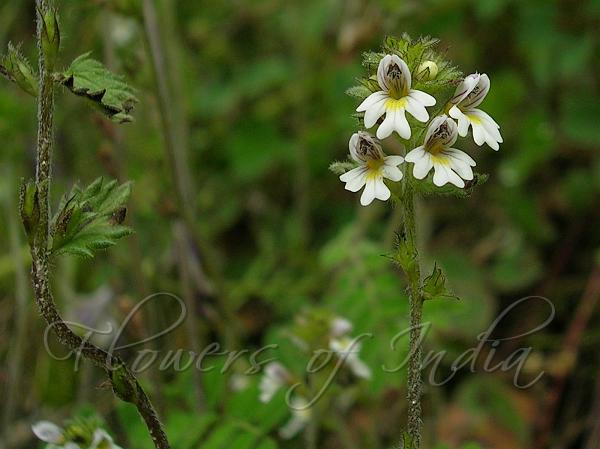|
| Himalayan Eyebright |
|

|

| File size | 211873 |
| Original date | 8/15/06 11:43 AM |
| Resolution | 2048 x 1536 |
| Flash | Flash did not fire, auto |
| Focal length | 8.0mm |
| Exposure time | 1/379s |
| Aperture | 3.2 |
| Focus Distance | |
| Metering Mode | Partial |
| Camera make | NIKON |
| Camera model | E3700 |
| Sensor type |
|
|
|
Photo: |
Botanical name: Euphrasia himalayica Family: Orobanchaceae (Broomrape family)
Himalayan Eyebright is a small, annual plant with deeply cut leaves, found wild in the
The plant is hemiparasitic - the roots have foodgathering nodules that attach
to the
roots of surrounding plants in order to obtain food. Therefore, eyebright is
difficult to cultivate, and virtually the entire supply is harvested from the
wild.
Himalayan Eyebright displays many small, white or purplish flowers variegated with
yellow. The various spots and stripes on the flowers cause them to resemble
bloodshot, or similarly afflicted, eyes. This, in turn, has caused the plant
to be used since the Middle Ages to treat such conditions. The usage was
obviously based on the so-called "Doctrine of Signatures." Most modem
herbalists recommend a lotion or infusion prepared from the entire overground
portion of the plant for conjunctivitis and other eye irritations. Chemical
studies of eyebright have identified a number of constituents, including
aucubin, caffeic and ferulic acids, sterols, choline, various basic compounds,
and a volatile oil. However, none of these constituents is known to possess
any useful therapeutic properties for the treatment of eye disease, nor are
there any modern scientific studies that attempt to measure the effectiveness
of the herb. Himalayan Eyebright is found in the forest undergrowth, especially in
ravines, wasteland and secondary forest in the Himalayas, from Kashmir
to SW China at altitudes of 2700-4200 m. Flowering: May-July.
| Identification credit: Navendu Pagé | Photographed in Valley of Flowers, Uttarakhand. |
• Is this flower misidentified? If yes,